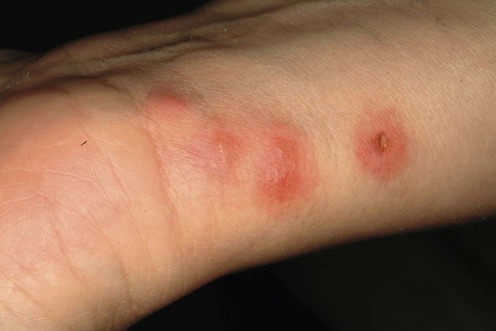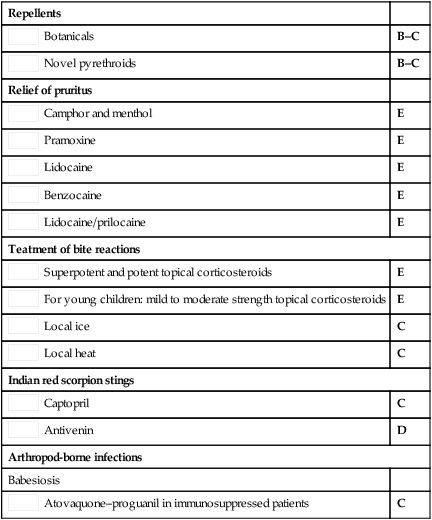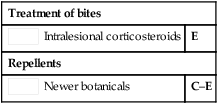Bites and stings

This chapter presents strategies for the prevention and management of bites and stings.
Specific investigations
Molecular characterization of Swiss Ceratopogonidae (Diptera) and evaluation of real-time PCR assays for the identification of Culicoides biting midges.
Wenk CE, Kaufmann C, Schaffner F, Mathis A. Vet Parasitol 2012; 184: 258–66.
The assays require improvement, but are promising for identification of small species of insects.
Usefulness of post mortem determination of serum tryptase, histamine and diamine oxidase in the diagnosis of fatal anaphylaxis.
Mayer DE, Krauskopf A, Hemmer W, Moritz K, Jarisch R, Reiter C. Forensic Sci Int 2011; 212: 96–101.
Elevated tryptase levels above 45 µg/L may support the diagnosis of fatal anaphylaxis.
First-line therapy
Second-line therapies
Third-line therapies





 DEET
DEET Permethrin
Permethrin Picaridin
Picaridin Combinations of DEET and permethrin
Combinations of DEET and permethrin Lufenuron
Lufenuron Fipronil
Fipronil Imidacloprid
Imidacloprid Epinephrine
Epinephrine Immunotherapy
Immunotherapy Rest, ice, and elevation
Rest, ice, and elevation Tetracycline or triamcinolone for brown recluse bites
Tetracycline or triamcinolone for brown recluse bites Antivenin for brown recluse bites
Antivenin for brown recluse bites Antivenin for black widow and red-black spider bites
Antivenin for black widow and red-black spider bites Antivenin for stings in Arizona
Antivenin for stings in Arizona Prazosin for Indian red scorpion stings
Prazosin for Indian red scorpion stings Lyme borreliosis
Lyme borreliosis Rocky Mountain spotted fever
Rocky Mountain spotted fever Human monocytic ehrlichiosis
Human monocytic ehrlichiosis Human anaplasmosis
Human anaplasmosis Babesiosis
Babesiosis
 Botanicals
Botanicals Novel pyrethroids
Novel pyrethroids Camphor and menthol
Camphor and menthol Pramoxine
Pramoxine Lidocaine
Lidocaine Benzocaine
Benzocaine Lidocaine/prilocaine
Lidocaine/prilocaine Superpotent and potent topical corticosteroids
Superpotent and potent topical corticosteroids For young children: mild to moderate strength topical corticosteroids
For young children: mild to moderate strength topical corticosteroids Local ice
Local ice Local heat
Local heat Captopril
Captopril Antivenin
Antivenin Atovaquone–proguanil in immunosuppressed patients
Atovaquone–proguanil in immunosuppressed patients
 Intralesional corticosteroids
Intralesional corticosteroids Newer botanicals
Newer botanicals
